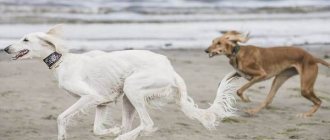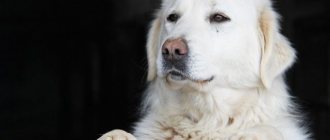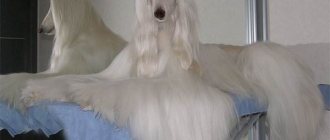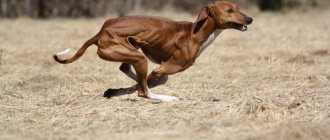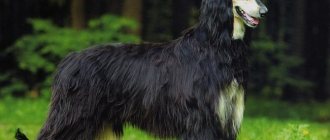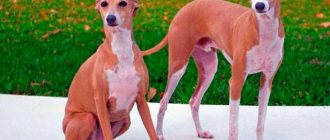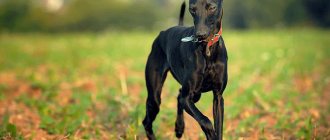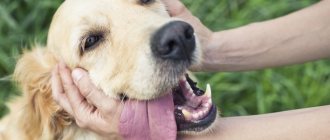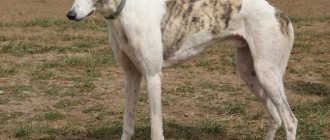Proud, noble, graceful, intelligent and sensitive - not every dog breed can boast such an enviable list of characteristics. The Saluki (Persian greyhound) is fully endowed with similar traits. There were times when in Eastern countries these dogs were more expensive than a thoroughbred horse.
Breed characteristics
| Short description | |
| Origin: | Middle East (country not specified) |
| Conditions of detention: | Country housing |
| Purpose: | Hunting |
| Color: | Anyone except brindle |
| Wool length: | Medium length, with fringes |
| Adult dog size: | The height of males is from 58 to 68 cm at the withers, females are slightly lower. Weight parameters have not been set. |
| Average life expectancy: | 12-15 years |
| Walk: | 2 times a day |
| Physical activity needs: | High level |
| Fédération Cynologique Internationale (FIC) classification: | Group No. 10 Greyhounds Section No. 1 Long-haired greyhounds or greyhounds with fringes |
| Puppy price: | On average: 25,000-70,000 rubles.
|
Description and breed standard
Male height at withers: 58-71 cm
Height of the bitch at the withers: proportionally less
Weight: 15.8-32 kg
Color: any colors and combinations are allowed, however, brindle color is extremely undesirable and points will be reduced for it at shows.
additional characteristics
The length of the body from the shoulders to the base of the tail should be approximately equal to the height at the withers, otherwise the dog will appear disproportionate.
The standard specifically states that the appearance of the animal must be noble . It is also specifically stated that movements should be swift, but graceful, and it should not be noticeable that the dog is making an effort.
The Saluki's coat There are long-haired and short-haired Salukis; the former have a kind of “fluff” of wool on their legs and head (and sometimes on their chest). They also have fluffy ears.
The nose is black or liver brown, the eyes are very dark to hazelnut colored, large and oval.
History of the origin of the species
The first mention of dogs of this type dates back to 3500 BC . The exact country of origin is not known for certain. It is noted that the homeland of these animals is the Middle East. Presumably the name of the breed comes from the city of Saluk, located in this territory. Dogs accompanied the nomadic Bedouins. The appearance of the animals changed depending on the habitat.
Dogs of similar appearance were also found in Egypt and Mesopotamia, depicted on frescoes and in tombs. The country's ruling elite used animals for entertainment - hunting birds, gazelles, rabbits and antelopes. At the same time, the dogs were delivered to the event site on horseback, along with their owners.
The qualities that underlay the selection were speed of movement and visual acuity. Dogs reach speeds of up to 70 km/h and are able to pursue a spotted target for a long time. It is unknown what breeds were used to create the Saluki, but research has revealed that they share genes with the wolf.
Animals of this species were considered very valuable; they were not sold, but could be given as gifts. Presumably this is how they got to China. It is known that the painting from 1427 depicts the emperor of the country along with a dog of a similar type. The first dogs were brought to Europe by participants in the Crusades. This fact is confirmed by medieval paintings depicting an unusual animal.
Large flows of Saluki into Europe began after the British conquest of the Arabian Peninsula in the 19th century. At the end of the century, F. Amherst brought several individuals to Great Britain and created a nursery. She is also the author of the first breed standard, developed in 1907.
After the discovery of Tutankhamun's tomb and the subsequent fashion for everything Egyptian, the Saluki gained popularity in Europe and was registered by the English Kennel Club. Interest in the country, and at the same time in the breed, subsided by 1930. The Second World War also significantly reduced the number of dogs.
At the moment, Salukis are popular in the Middle East and all Muslim countries. There, dogs are considered a “gift from Allah”, and the only “pure” animals among dogs . In other countries, representatives of the breed are present, but they are not the most fashionable.
Diseases and life expectancy
The lifespan of the Persian Greyhound varies between 12-14 years. Animals of this species may suffer from certain diseases, in particular:
- cardiomyopathy;
- hypothyroidism;
- Salukis are highly sensitive to anesthesia. They need to administer it in smaller volumes than dogs of other breeds, but having the same weight.
Experts are sure that Persian greyhounds are strong dogs. According to their observations, only 5% of dogs can encounter pathologies.
Distinctive features
Arabian Greyhounds must meet the parameters set by the FCI standard. Basic requirements of the regulatory document:
- The head is narrowed, of pronounced length, has a noble and graceful appearance . The forehead is not convex, the stop is almost invisible.
- bite . The jaws are strong, the teeth are complete.
- The lobe is black or brown.
- The eyes are oval-shaped, large, but do not give the impression of being bulging. The color of the iris varies from walnut tone to dark and rich. The look is meek, but emphasizing one’s own dignity.
- The neck is muscular, elongated, graceful.
- The ears are of pronounced length and are distinguished by a high set. At rest they are adjacent to the muzzle, in other cases they are mobile.
- The tail is low set, reaching to the hock joint or below. Slightly curved, creates a natural impression. Usually does not rise above the line of the spine.
- The torso is square in shape, but due to the thin physique and strongly toned abdomen, a feeling of elongation is created. The sternum is stretched in length, not flat. The ribs are clearly visible. The wide back goes into a slightly arched lower back.
- Legs are straight, powerful, with developed thighs and shins. The pasterns are flexible, have a slight slope, the shoulder blades are set back, the same length as the shoulders. The paws are medium-sized, flexible, with elongated toes, between which there is thick hair.
- The movements are light, without raising the forelimbs, and turn into a trot.
- The coat is presented in 2 variants : completely smooth and type with feathering. In any case, the hair is soft and shiny. Feathering in adult Salukis is present on the limbs, back of the thigh, and throat. Long hair covers the ears and the lower part of the tail.
History of the Saluki Greyhound breed
History of the breed: Historical sources indicate that the Saluki dog breed is the oldest. It is known that images of dogs similar to Persian greyhounds were found on the tombs of pharaohs and ancient dishes.
In the Middle East, for several thousand years in a row, these animals served only for hunting. Each tribe had its own variety of this breed, most suitable for hunting certain game in a certain area. Previously, Salukis could not be sold or bought, but were only allowed to be given and received as gifts. For this reason, the Persian greyhounds that eventually came to Europe differed in their place of origin, and therefore in appearance.
In modern history, Saluki dogs are in great demand. In Russia there is a national club of this breed that organizes exhibitions and races.
The video below will tell you more about Saluki:
Photo of an adult dog
Character, abilities, skills
The Persian Greyhound is an independent but affectionate dog, affectionate to its owner and merciless towards game. The developed instinct of pursuit cannot be broken either by obstacles on the way or by the orders of the owner.
Over a short distance, a Saluki can reach speeds of up to 90 km/h, and over a long distance – up to 70 km/h. In the yard, these curious dogs are always looking for game - any ball, pebble, bag will be carefully studied and inspected. Saluki is designed for hunting in open areas - in the steppe, desert, etc.
To maintain health, a dog needs the opportunity to run around to its heart's content; an excellent solution would be to chase a mechanical hare in a coursing course. For a beginner, this beautiful breed is unlikely to be suitable due to its tendency to disobey and run away, as well as to make independent decisions.
The breed is peaceful, not hot-tempered, but can be touchy.
The Saluki enjoys being the object of attention and engaging in active play. You can ruin a dog's character with loud screams and rough training, making it withdrawn and indifferent.
A naturally sensitive Saluki does not take well to negativity in the family - squabbles, discord, showdowns , all this can ruin her manners.
A calm and balanced greyhound is very sensitive, chooses one owner, is indifferent to strangers, but is always on the alert, and will warn of their appearance with a loud bark. The breed is sociable and pliable, it tries to be near the owner and at the same time stay in the shade.
Greyhounds get along well with children, they appreciate their spontaneity and tirelessness in games, but you should explain to the child that the dog will not tolerate rudeness. She is tolerant of other animals in the house, especially benevolent breeds of dogs (beagles, Estonian hounds, basset hounds).
Photos of puppies
Features of character and behavior
Saluki with its entire appearance shows nobility of origin and self-esteem. Has a bright breed character.
Advantages
- Dogs of this species have an even and calm character. They do not provoke fights, get along with other dogs, but are not timid or shy.
- Salukis are attached to their owner, but do not try to bother him with their company.
- They are affectionate with the owner and family, love their company, but prefer the position of simply being nearby.
- Dogs calmly react to the appearance of strangers and rarely bark at them.
- They also coexist comfortably with children (except for the smallest ones).
- Representatives of the breed will not show aggression, even if the child handles them carelessly; they will rather simply leave.
Flaws
- Despite its devotion to its owner, the dog does not obey unquestioningly. During the pursuit, she may well ignore his commands. The same situation will arise if the dog is tired of training, is tired or is not interested.
- Due to its strong hunting instinct, the animal should only be walked on a leash.
- When prey of any kind is detected, the dog will begin to hunt, and given its speed of movement and ability to jump high, it will be difficult to catch up with the Saluki.
- Also, the dog will not tolerate the presence of small pets on its territory.
- Salukis do not accept rudeness, shouting, or swearing, even if they are not directed at her. The animal will be nervous and worried.
- You can also note the touchiness and vulnerability of such a pet, his love of freedom and stubbornness.
- The low sociability inherent in the breed does not allow them to become everyone’s favorite, because in relations with strangers they remain neutral.
Dog and man
This is not to say that the Saluki is suitable for keeping in an apartment. Like any hunting breed, it needs to realize its irrepressible energy. The best place to live would be a house with a fenced yard . The fence must be high.
Since the popularity of hunting, especially in European countries, has fallen, the Saluki is gradually transforming into a companion dog without losing its excellent physical shape. She has attracted many people with her devotion and will be able to become a family dog. At the same time, you must always remember that she will adore only one person , and just treat the rest well.
By the way, when choosing this breed, you should carefully evaluate your willingness to spend her entire life with her: the Saluki will not be able to accept a new owner , she will remember the first owner, and this will affect her behavior and mood.
With children, this dog will be careful and restrained, but will not allow any pinching or kicking in its direction. Rest assured, she will respond, not necessarily with a bite. She may growl and bark loudly, although the possibility of biting cannot be completely ruled out. Therefore, this breed is recommended for those whose children have already grown to a more or less conscious age.
The Saluki is not very suitable for older people, as it requires a lot of physical activity and a firm hand when training. However, if you are full of life, then this pet will only add color to it.
Salukis are favorable towards representatives of their breed and can accept another dog. There were cases when these pets got along with cats, but in this case the cats were the first pet in the family.
Important: do not risk having any small pets after this swift beauty has appeared in your home. Its hunting instinct cannot be suppressed by any training. That's why cats, rabbits, ferrets, guinea pigs and chinchillas are taboo!
Care and maintenance
Saluki wool is easy to care for. However, its length and density make it necessary to use overalls in winter.
Their physique and lack of fat require a soft and warm bed. Otherwise, the dog will sleep on the owner's bed.
Closed ears require the owner's attention. It is necessary to frequently inspect the inside and clean it on time. This way you can avoid inflammation and also not miss the appearance of a tick. The eyes are examined weekly and, if necessary, washed with water or chamomile infusion.
The claws usually grind down on their own, because... This is an active dog, but it is advisable to monitor their condition monthly and trim them if necessary. Teeth need to be cleaned 1-2 times every 7 days. Overall, this is a healthy dog with no genetic problems.
Nutrition
Representatives of the breed have a thin build and rarely gain excess weight. Their activity allows them to burn a lot of calories, which maintains their natural shape. However, due to high energy costs, it is worth feeding a pet of this breed more often than others.
Usually, for adult dogs over 10 months , feeding twice a day is sufficient; it is better to offer Salukis 3 meals . The frequency of feeding puppies is slightly different. Two-month-old babies are fed 5 times a day , after 2 months it is reduced to 4, and by six months to 3 .
Salukis are not prone to allergies, so they can be fed natural food. Preference should be given to lean meats, offal, vegetables, unsweetened fruits, and dairy products. Among porridges, it is better to choose rice or buckwheat. Twice a week you should include eggs and sea fish in your diet.
It is forbidden to feed too salty, fried, pickled or spicy, as well as give bones and chocolate.
It is acceptable to use professional dry or wet food as the basis of nutrition. They have a balanced diet and sufficient amounts of vitamins. It is advisable to choose food of the premium or super-premium level and the “for active breeds” category.
We recommend that you read a detailed article on the topic: “How and what to feed a dog: types and characteristics of nutrition.”
Health
This breed is not artificially bred; a long period of natural selection has created a genetically healthy dog.
Vaccinations
Vaccinating your pet allows you to develop immunity to common dangerous diseases. 7 days before each procedure, it is necessary to give the animal an anti-helminth remedy. Babies are vaccinated twice, at 8 and 12 weeks , and adult dogs once a year .
Diseases that vaccination will protect against:
- plague;
- hepatitis;
- parovirus enteritis;
- rabies;
- coronavirus;
- parainfluenza;
- leptospirosis;
- trichophytosis.
After the vaccine is administered, the puppies are quarantined, because... immune defense has not yet developed. At this time, the owner must monitor the health of the pet; if the temperature rises, vomiting or other health problems, it is necessary to show the baby to the veterinarian. During the quarantine period, it is prohibited to walk your pet outside.
Important article on the topic: “Everything you need to know about dog vaccinations.”
Diseases
Salukis have almost no health problems, especially of a genetic nature. Possible diseases include:
- Cardiomyopathy . A pathology that disrupts the normal contractility of the myocardium, as well as reducing the pumping function of the organ.
- Hypothyroidism . Suggests decreased production of thyroid hormones.
- Hemangiosarcoma . A malignant tumor that occurs inside blood vessels.
Other medical complications include an increased reaction to anesthetic compounds. In this regard, it is necessary to give them a lesser dose of anesthesia than representatives of other breeds.
Walk
Saluki is a very active breed . They will not be able to stay at home without harming their health. They need to run and jump, so it is better to walk your pet in a park where there is enough space, or keep it in a country house with a large yard. Representatives of the breed will be interested in overcoming obstacles and accompanying the owner while rollerblading or cycling. Dogs pay almost no attention to toys, balls and frisbees.
When walking, it is worth taking into account the animal’s hunting instincts; after seeing the target, the dog may stop reacting to the owner. Therefore, it is better to keep your pet on a long leash, or let it go only in a fenced area . The fence should be high; a small Saluki can overcome it without any problems. At the request of the owner, you can involve the dog in training for hunting tasks, or engage them in coursing.
Grooming
- The coat of representatives of the breed is not very long, except for the area of the ears, tail and feathers, so it does not cause any special problems in care.
- It needs to be combed weekly, and during shedding or after going outdoors, additionally treat it with a comb.
- If dirty, wipe the pet's paws and fur with a damp cloth. It is not recommended to bathe your dog too often, so as not to spoil the condition of the coat.
If washing cannot be avoided, it is better to do it without using shampoo and soap. Full treatment is advisable no more than once a year.
Training and education
Due to its willfulness and proud disposition, this breed of dog is not easy to train. First, the Saluki will test its owner's strength. Only when she sees him as a leader will she agree to obey. The pet will not listen to just anyone. Therefore, the educational process should be based on the manifestation of rigidity.
However, no one has ever succeeded in weaning a greyhound from its hunter instincts. You can begin to introduce the animal to society after the second vaccination and the end of quarantine. Experts advise appearing with your pet in crowded places for 4 weeks, giving it the opportunity to adapt to society, learn new smells and stop being afraid of strangers. If the establishment of a Saluki is connected with the desire to hunt, then you can start introducing it to animals from the age of one.
Mating
Dogs that have documents of origin (pedigree), as well as the necessary exhibition achievements, are allowed to breed. In this case, it can be guaranteed that the puppies will have an exterior characteristic of the breed, as well as sufficient health. Both parents must reach 2 years of age , be vaccinated according to age and treated for helminths.
It is better to introduce a couple selected at the club on neutral territory. After this, you need to wait until the pets calm down and begin to show interest in each other. Next, you should move to the male’s territory, where mating will take place. The meeting is repeated 1-2 more times at intervals of 24 hours.
Read a detailed article on the topic: “Everything you need to know about breeding dogs: appropriate age, what to do if it doesn’t work out, rules and tips.”
Personality of the Persian Greyhound (Saluki)
The character (behavior) of the Saluki greyhound dog is calm and balanced, which is why large houses often contain several dogs of this breed at once. These dogs feel comfortable both in an apartment and in the countryside. They love an active lifestyle. Since ancient times, they have had a hunting instinct, so they hunt for everything that moves, abruptly taking off in pursuit. The spoils are always brought to the owner.
The proud and slightly aloof pet is affectionate and friendly only with family members, and is unsociable and wary with other people. By nature, he is restrained, unobtrusive, independent, independent. Loyal to the owner, tries to earn his favor.
Key points in training
The proud, stubborn and uncommunicative nature of the Saluki makes it difficult to train.
- Despite his devotion to his owner, the dog will not ingratiate himself and try to attract his attention by complete submission.
- He may ignore commands if he is uninterested, tired, or simply doesn't want to.
- You cannot force or swear at a Saluki, the dog will be offended.
The best strategy is to teach through play or treats, with a short period of practicing one task, resting, and moving on to a new command. It is better to start raising and training Salukis from a very early age in order to reinforce basic behavioral skills. If the owner has little experience, it is better to seek the help of a professional.
Read about how to properly train a dog in the article: “Training a puppy: effective methods from dog handlers, learning commands at home.”
Additional Information
Royal dog of Egypt. The Egyptian nobility considered the breed a valuable and honorable companion, and dogs were known to be mummified in the manner of Egyptian pharaohs. The remains of Persian greyhounds have been found in tombs on the upper Nile.
Self-sufficient dog. Salukis are part of the greyhound group. When hunting, greyhounds rely only on their eyesight. They track prey with their eyes and catch it at lightning speed. People can't keep up with these fast dogs, so the dogs work alone. Because of this feature, the Saluki's character is extremely independent.
Deceptive vulnerability. Salukis look very fragile, graceful and weak. Few people know that these dogs are capable of reaching speeds of about 50-70 km per hour, and some individuals can run at a speed of 90 km per hour. The Saluki is considered one of the fastest dogs in long distance racing. In addition, the Persian Greyhound is famous for its endurance and ability to work in almost any climatic conditions.
Webbed feet. Salukis have special membranes between their toes that allow them to run freely on sticky sand.
Luxury lovers. Due to their fragile constitution and fine coat, Persian greyhounds prefer to lie on sofas, beds and loungers.
Subtle soul. Sensitive Salukis do not tolerate family discord well. Conflicts and quarrels can negatively affect the character of a susceptible dog.
Smoothies. Among the breed there are individuals without long decorative hair on the ears and tail. Such dogs are called “smooths,” which means “smooth” in English.
How to choose a puppy
A healthy Saluki baby can only be purchased from trusted breeders or a nursery. Animals purchased without documents cannot be guaranteed to match the breed or have no diseases. When visiting a breeder, you should check the pedigrees of the parents, their veterinary passports, and the puppy's birth certificate.
It would be useful to observe the parents of the future pet, in this way you can assess its potential appearance as an adult, as well as see the main behavioral traits. It should be noted that the puppy does not have fringes, even if the parents have them. The baby will only have downy hair in these areas.
When getting to know a young Saluki, you need to evaluate his reaction to the approach of strangers, noise, and also watch him play with his brothers and sisters. The puppy should not show timidity, cowardice, or aggression. The dog may be interested, but not excited.
The Saluki is an excellent pet for those who appreciate natural breeds with a distinctive character. The owner is required to respect the dog, patience, proper level of workload and education. If these conditions are met, the owner will receive a loyal, balanced animal, whose appearance has not changed much since the times of Ancient Egypt.
5 / 5 ( 1 voice )
Health
The average life expectancy of salūqī is 13-14 years. It depends on the owner whether his pet will become a long-liver. It is the owner who must provide proper nutrition, proper care, and decent living conditions.
The Persian greyhound rarely gets sick. You need to keep your dog's body in excellent condition by doing routine vaccinations, deworming, and treatment for ticks and fleas. Annual preventive examinations at a veterinary clinic are also recommended.
One cannot help but rejoice in the fact that diseases affect no more than 4-6% of the Saluki breed. It is worth noting that genetic diseases are not observed in the Persian Greyhound. But the owner of a gazelle dog should be aware of some health problems:
- Intolerance to anesthesia - if anesthesia cannot be avoided, it should be used very carefully, given the sensitivity of the Saluki to it. The intolerance is explained by the fact that representatives of the breed have almost no fat layer. The amount of anesthesia taken is less than for other types of dogs.
- Hypothyroidism is a dysfunction of the thyroid gland. The disease is difficult to diagnose.
- Cardiomyopathy - changes in the structure and functionality of the muscle tissue of the heart are observed.
A common cause of illness is lack of physical activity and lack of walking. Activity and running are vital.
